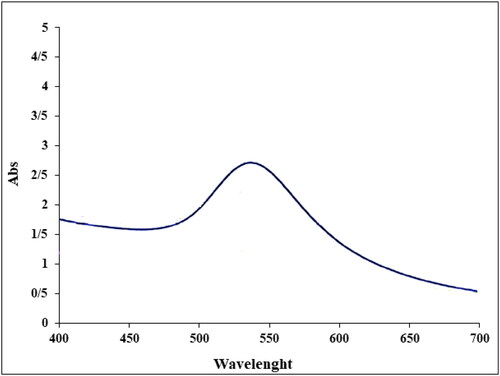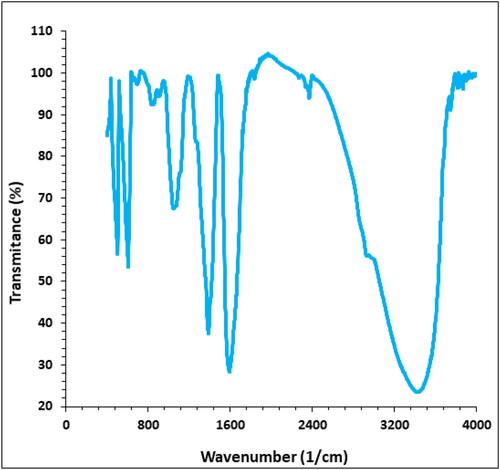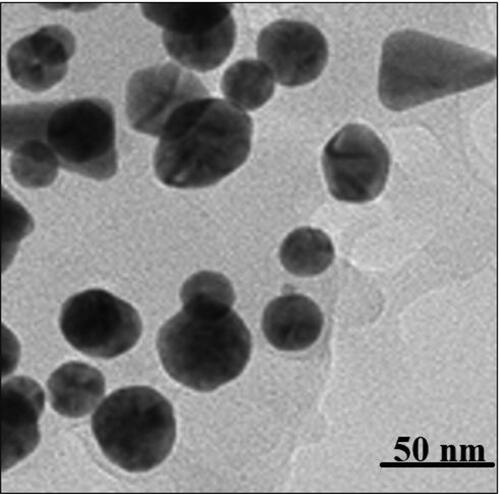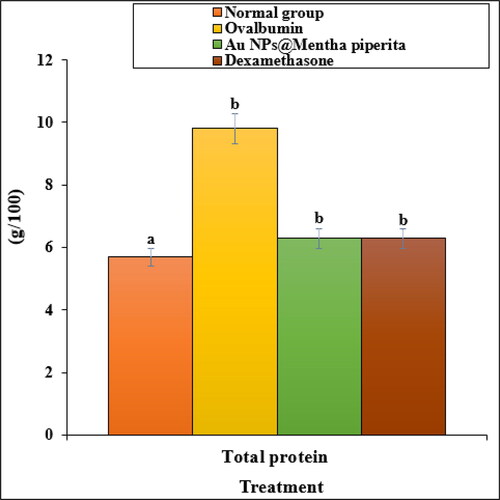Abstract
Regarding applicative, facile, green chemical research, a bio-inspired approach is being reported for the synthesis of Au nanoparticles by Mentha piperita as a natural reducing and stabilising agent in alkaline medium without using any toxic reducing agent. The biosynthesized Au NPs@Mentha piperita were characterised by advanced physicochemical techniques like ultraviolet-visible (UV-Vis), Fourier Transformed Infrared spectroscopy (FT-IR), Scanning Electron Microscopy (SEM), Transmission Electron Microscopy (TEM), Energy Dispersive X-ray spectroscopy (EDX), and X-ray Diffraction (XRD) study. It has been established that Au NPs@Mentha piperita have a spherical shape with a mean diameter from ∼10 nm. To survey the cytotoxicity effects of Au NPs@Mentha piperita, MTT assay was used on HUVEC cell line. To survey the antioxidant properties of Au NPs@Mentha piperita, the DPPH test was used in the presence of butylated hydroxytoluene as the positive control. The Au NPs@Mentha piperita inhibited half of the DPPH molecules in the concentration of 113 µg/mL. In the in vivo, wistar rats were divided to four groups; non-sensitised, sensitised to ovalbumin, sensitised and treated with dexamethasone (1.25 μg/mL), and Au NPs@Mentha piperita (5 μg/mL) in drinking water for 21 days. The levels of total protein (TP), phospholipase A2 (PLA2), immunoglobulin E (IgE), IFN-γ/IL-4 ratio, interferon gamma (IFN-γ), and interleukin 4 (IL-4) in BALF, and lung pathological changes were examined. A significant increase in PLA2, IgE, IL-4, and TP levels, all lung pathological indices as well as significant decrease in IFN-γ/IL-4 ratio was seen in the asthmatic compared to the control rats. Treatment with Au NPs@Mentha piperita (5 μg/mL) resulted in decreased PLA2, IgE, IL-4, and TP levels, but increased IFN-γ/IL-4 ratio compared to untreated sensitised rats. The Au NPs@Mentha piperita significantly improved the pathological changes of sensitised rats. The improvement effects of higher concentrations of the Au NPs@Mentha piperita extract were significantly more than those of dexamethasone. The improvement effects of Au NPs@Mentha piperita on pathological changes, immunological and inflammatory markers in sensitised rats comparable or even more potent than dexamethasone suggests the therapeutic potential of the nanoparticle in asthma. After confirming these results in clinical trial studies, Au NPs@Mentha piperita can be used as a new drug for the treatment of asthma in humans.
1. Introduction
Mentha piperita L. is a plant with a warm and dry nature that has many medicinal properties. It can be consumed in various forms such as fresh, dried, essential oil, brewed, powder, etc. Mentha piperita leaves contain the highest amount of antioxidants compared to other plants [Citation1–3]. Mentha piperita oil contains phenolic acids, phytosterols, saponins, triterpenes, flavonoids, carotenoids, anthocyanins, etc. Phosphorus, iron and calcium with vitamins C and A Mentha piperita are very important for skin cell repair and growth. These vitamins and minerals also form parts of the cell wall in the circulatory system that are vital to life [Citation4–7]. Mentha piperita oil is widely used for various purposes. This oil is widely used today in the preparation of foods, perfumes and to treat various types of problems. Mentha piperita is soothing and has cleansing and detoxifying properties. Mentha piperita prevents inflammation in the stomach, cleanses the palate and strengthens the digestive process. This is due to the activation of the salivary glands in the consumption of Mentha piperita, which enables digestive enzymes to produce sufficient amounts [Citation2–6]. Mentha piperita, the release of digestive enzymes enables the body to consume more fat to produce energy. Mentha piperita is a very useful plant to increase liver strength due to its essential nutrients and properties such as its sedative and soothing properties [Citation5–8]. People who are regular consumers of Mentha piperita are extremely alert and intelligent. Mentha piperita is known to be an effective stimulant, which increases long-term memory retention and clear alertness. Mentha piperita is a very fragrant natural stimulant that increases energy in the body. It can be used as an oil or inhaler or as a steamer to reduce depression and fatigue. It stimulates the mind, strengthens it and increases the overall state and function of the body. Due to the anti-inflammatory nature of Mentha piperita leaves, it is likely that the red and swollen areas within the respiratory tract will be relieved in a short time by eating a fresh Mentha piperita [Citation3–6]. The oils contained in Mentha piperita are widely known to resist the release of certain chemicals in the body, which can also lead to seasonal allergies and hay fever. Mentha piperita is best consumed raw or in the form of tea, to protect against allergies [Citation2–6]. These benefits also make Mentha piperita leaves great for coughs and other problems that are exacerbated by sudden and sudden contractions of muscles in the surrounding area. Mentha piperita is used in the form of tea or chewing gum to relieve congestion of the throat, nose, bronchitis and lungs [Citation1–4]. It helps soothe the nose, throat and airways and prevent a long-term disorder that usually starts with asthma or colds. Mentha piperita has soothing properties and is very useful for patients with asthma, because it causes blockage in the nasal tube. However, the amount and frequency of Mentha piperita consumption should be controlled as overuse may lead to nasal and gastric irritation [Citation4–8].
Asthma is a chronic inflammatory disease characterised by reversible obstruction of the small airways. Symptoms include attacks of shortness of breath, cough, and wheezing (classic triad). It may wake the person up due to the severity of the symptoms or lead to hypoxia, cyanosis, and suffocation [Citation9–12]. Causes (triggers) mentioned for asthma include: Infections (especially viral types); Pollutants, some medications, some occupations, exercise and psychological causes. In both conventional and traditional Iranian medicine, there are treatments for asthma that fall into two categories: For immediate control and for long-term control [Citation10–12]. Traditional medicine uses methods for immediate control of asthma to divert phlegm to places other than the airways and lungs, and for long-term control of phlegm excretion from the body in general [Citation9–11]. To link herbal medicines in the world's pharmacopoeias to the advice of scholars in traditional medicine texts in the treatment of asthma, extensive searches were made in a number of reputable herbal medicine books available in pharmacopoeias of some developed countries [Citation10–12]. In total, about 130 plants and their products with anti-shortness of breath and asthma properties were found, of which about 30 are specific and specific cases for the treatment of asthma. To date, the use of nanotechnology continues to provide numerous benefits in the treatment of various chronic diseases and leads to significant improvements in treatment outcomes [Citation9–12]. The use of nano-based delivery systems such as liposomes, micelles and nanoparticles in pulmonary drug delivery has shown a promising strategy in achieving drug deposition and maintaining controlled drug release in the lungs. They have been widely used to minimise the risks of drug toxicity in the body [Citation9–11].
Nanotechnology is defined in different ways in several countries, which affects the nanodrugs clinical validation. However, what these different definitions have in common is the use of nanoscale structures. There are several distinct benefits to using nanotechnology in the diseases treatment [Citation13–15]. Nanoparticles, especially metal nanoparticles and metal oxides, have been widely used by medical consumers and manufacturers. The mechanism of nanoparticle-induced toxicity against cancer cells is the production of reactive oxygen species (ROS). Excessive production of reactive oxygen species can lead to oxidative stress, disruption of normal physiological maintenance, and oxidation regulation [Citation12–15]. These effects in turn lead to DNA damage, unregulated cell signalling pathways, changes in cell evolution, cytotoxicity, apoptotic death, and the onset of cell death. Critical-deterministic factors can affect the production of reactive oxygen species. These critical-deterministic factors include shape, size, nanoparticle surface area, particle surface baroelectricity, surface-forming groups, Particle solubility, metal ion emission from nanomaterials and nanoparticles, optical activation, model of cell reactions, inflammatory effects and ambient pH [Citation11–15]. Metal nanoparticles and oxides of metal nanoparticles due to their optical properties due to the large active area and high atomic number, amplify the photoelectric and Compton effects of both X-ray and gamma-ray interactions with the adsorbent in the diagnostic and therapeutic range [Citation9–14]. Finally, they can lead to the development of methods for the destruction of tumour cells and reduce their survival with minimal side effects in radiation therapy [Citation12–15].
In this study, the anti-inflammatory and immunomodulatory properties of Mentha piperita green-formulated gold nanoparticles and its effect on ovalbumin-induced asthma and lung pathological changes were investigated in rats.
2. Material and methods
2.1. Materials
The Mentha piperita plant, which is applied in this study as a factor for reducing metal ions and stabilising nanoparticles, has been prepared from the mountainous areas. HAuCl4, ethanol and methanol were purchased from Merck.
2.2. Preparation and extraction of aqueous extract
First, it was necessary for the experiments to provide a pure solution of the extracts of the leaves of Mentha piperita plant. To do this, 1.5 g of leaf powder was added to 60 mL of deionised water. Then, the resulting solution is placed on a hot plate at 60° C for 2.5 h to dissolve plant agents and metabolites well in the solvent. The resulting solution was poured into the Falcon tubes, and centrifuged at 5000 rpm for 10 min to separate the plant residue from the extract. Then, the resulting extract was moved into test tubes, and placed in the refrigerator to keep it fresh and healthy.
2.3. Green synthesis and chemical characterisation of gold nanoparticles
The biosynthesis of AuNPs, a 10 mL of aqueous extract solution (20 mg/mL) was added to 30 mL of HAuCl4.6H2O in the concentration of 0.02. The mixture was stirred for 90 min at 50 °C. The colour-changing from yellow to black indicated the formation of gold nanoparticles. The precipitate was triplet washed with water and centrifuged at 12000 rpm for 15 min subsequently. The obtained black powder was kept in a vial for the chemical characterisation and evaluation of its biological activity.
Different spectroscopic and imaging techniques were used to evaluate and identify the AuNPs. At the first step, UV-vis spectrum (Cary UV-Vis 4000, Agilent) was used to identify gold nanoparticles. Typically, gold nanoparticles have two absorption spectra in the range of 400–700 nm. The FT-IR spectrum (PERKIN-ELMER, RXI) was used to identify nanoparticles and plant metabolites in plant extracts. TEM (H9500, HITACHI) was also used to examine the shape and size of nanoparticles.
2.4. In vivo design
Young male rats (60) of Wistar strain weighing 220–250 g were procured. The experimental animals were housed in a temperature controlled room (24 ± 1 °C) with 12:12 h L:D illumination cycle. Rats were sensitised as previously described [Citation16]. Rats were divided to four groups; non-sensitised, sensitised to ovalbumin, sensitised and treated with dexamethasone (1.25 μg/mL), and Au NPs@Mentha piperita (5 μg/mL) in drinking water for 21 days. The levels of total protein (TP), phospholipase A2 (PLA2), immunoglobulin E (IgE), IFN-γ/IL-4 ratio, interferon gamma (IFN-γ), and interleukin 4 (IL-4) in BALF, and lung pathological changes were examined. Briefly, 1 mg/kg ovalbumin (OA) plus 100 mg Al(OH)3 was administered intraperitoneal (i.p.) and rats were exposed to 2% OA aerosol with air flow of 8 lit/min for 20 min/day in a 0.8 m3 chamber, with animal normal-breathing. Saline was used instead of the ovalbumin solution in the control rats. One day after the end of sensitisation, animals were sacrificed by i.p. administration of 50 mg/kg ketamine and 5 mg/kg xylazine. The left lung was washed with one mL saline five times (5 mL totally). BALF was centrifuged at 2500 g at 4 °C for 10 min and supernatant was stored at − 70 °C [Citation16] until analysis. Cytokine and inflammatory levels including interleukin 4, interferon gamma, immunoglobulin E, phospholipase A2 and total protein in the BALF were measured by enzyme-linked immunosorbent assay (ELISA) sandwich method with appropriate protocol recommended by company. The ratio of IFN-γ/IL4 as an index of Th1/Th2 was also calculated [Citation16].
The results were evaluated as Mean ± SE using SPSS software version 12 and statistical tests of variance of completely randomised block design. Drawing graphs in Excel software was performed and the significance level of the differences was considered p < 0.05.
3. Results and discussion
UV-Vis is based on the irradiation of ultraviolet and visible photons on the sample and measures the rate of passage or absorption of matter at different wavelengths in the range of 200 to 1100 nm. It is possible to measure the spectrum for samples in solution, solid as well as thin layers. The size of solid samples should be larger than 20 mm. This test is not possible for powder samples. One of the important applications of UV device is to determine the concentration of the unknown solution. By having the original sample and its solvent and making several solutions with different percentages and drawing a calibration diagram based on the calculation of the maximum land, the concentration of the unknown solutions can be calculated [Citation10].
The successful biosynthesis of AuNPs using Mentha piperita leaf aqueous extract was observed visually. displays the UVs absorption spectrum of the AuNPs. The spectrum of AuNPs exhibited a peak at 537 nm due to intrinsic bandgap absorption, which is confirmation of AuNPs. During the biosynthesis of AuNPs, the colour of the reaction solution changed to dark red after mixing plant extract with HAuCl4.
FT-IR (Fourier Transform Infrared) has been a suitable technique for analyzing materials in the laboratory. An infrared spectrum represents the fingerprint of the sample under test with absorption peaks, which depends on our vibrational frequencies between the atomic bonds of that material. Since each substance has its own atomic bonds, no two compounds with the same infrared spectrum are alike. Hence, infrared spectroscopy can be effective in better identification (qualitative analysis) of different types of materials. In addition, the peak sizes are in the range indicating the amount of material present. Advanced software algorithms make this spectroscopy a great tool for quantitative analysis [Citation10].
According to (FT-IR spectrum), the extract revealed peaks corresponding to hydroxide and carboxyl functional groups of phytochemical substances. Stretching of the Au-O peak was observed at 513 cm−1. C-H stretching at 2379 cm−1, COO asymmetric and symmetric stretching at 1856 cm−1 and 1608 cm−1, respectively, and OH stretching at 3422 cm−1 were observed. These peaks are also observed in the spectra of the AuNPs, which also displayed a redshift from the COO symmetric and asymmetric stretching from the extract. This indicates that the carboxyl group is bound to the surface of the AuNPs and acts as a stabilising agent. The effective formation of AuNPs may be attributed to the phytochemical compounds present in the Mentha piperita aqueous extract, which can act as reducing as well as stabilising agents for the reduction and formation of AuNPs.
TEM (transmission electron microscope) is used for determining the structure and morphology of materials. TEM transmission electron microscope products enable microstructural studies with high resolution and high magnification such as studies of crystal structures, symmetry, orientation and crystal defects. TEM and SEM microscopes differ in how the beam passes and the information obtained from the sample. Scanning microscopes take pictures of the sample surface, while passing microscopes take pictures of the inside of the sample. The resolution and magnification of electron microscopes are higher than those of scanning electron microscopes. The electron beams in the scanning electron microscope scan the surface of the sample point-by-point, but the TEM microscope beams hit and pass through the entire sample. In addition, sample preparation for the SEM microscope is easier than for the TEM microscope [Citation10].
shows the shape and size of the AuNPs using TEM techniques. The fast reduction of the gold ions by the Mentha piperita aqueous extract allowed homogeneous nucleation of gold metals, which cause to form AuNPs with small size. The AuNPs are confined within a Mentha piperita matrix, likely comprised of biomolecules that are acting as a stabiliser or capping agent during synthesis. The obtained AuNPs found spherical and the size of 13–58 nm. In rare cases, particles with larger sizes were also seen in the sample, but their numbers were rather low.
BALF level of IFN-γ in ovalbumin group was significantly different compared to normal group. There were significant decrease in BALF level of IFN-γ in Dexamethasone group compared to normal group. Treatment of sensitised rats with two low concentrations of the Au NPs@Mentha piperita and dexamethasone led to significant decrease in IFN-γ as compared to ovalbumin group. A significant difference in BALF level of IFN-γ between Au NPs@Mentha piperita and Dexamethasone groups was also seen (). BALF level of IL-4 in ovalbumin group was significantly higher than normal group. BALF level of IL-4 in Dexamethasone and Au NPs@Mentha piperita groups were significantly lower than ovalbumin group. There reduction of IL-4 level in Au NPs@Mentha piperita group was not significantly more than Dexamethasone group (). The ratio of IFN-γ/IL-4 was decreased in all untreated and treated sensitised groups compare to normal group. The ratio of IFN-γ/IL-4 in Au NPs@Mentha piperita group was also significantly higher compared to Dexamethasone group (). BALF IgE level was significantly higher in ovalbumin, Dexamethasone, and Au NPs@Mentha piperita group compared to that of normal group. The BALF IgE level in Dexamethasone and Au NPs@Mentha piperita groups were significantly decreased compared to ovalbumin group. BALF IgE level in treated group with high concentration of the Au NPs@Mentha piperita was also lower than Dexamethasone group ().
Figure 4. The effect of Au NPs@Mentha piperita on interleukin 4 (IL-4), interferon gamma (IFN-γ), and IFN-γ/IL-4 ratio parameters in ovalbumin-induced asthmatic rats.
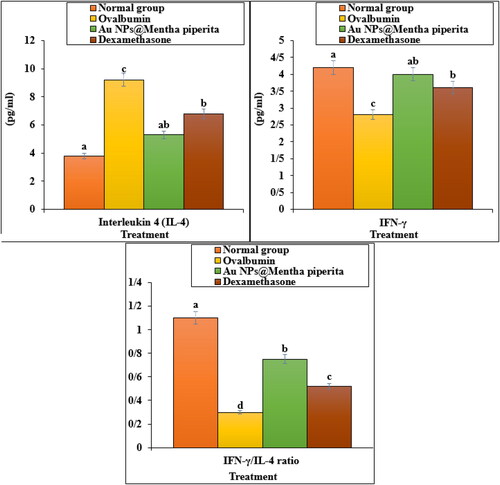
Figure 5. The effect of Au NPs@Mentha piperita on Ig E parameter in ovalbumin-induced asthmatic rats.
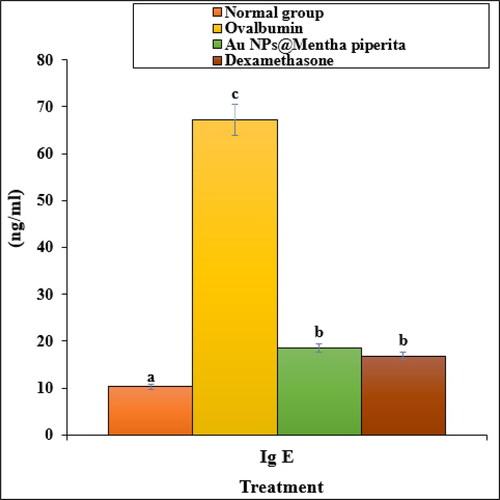
BALF level of PLA2 in ovalbumin group were significantly higher than normal group. The level of PLA2 was decreased in all treated groups. BALF level of TP in ovalbumin group was significantly higher than normal group (). The level of TP was decreased in Dexamethasone and Au NPs@Mentha piperita groups compare to ovalbumin group. The mean value of TP in Au NPs@Mentha piperita group was not significantly lower compared to Dexamethasone group. There was significant difference between Au NPs@Mentha piperita and normal groups, ().
4. Conclusion
The aim of this study was to synthesise green AuNPs using Mentha piperita extract and to investigate the therapeutic properties of gold nanoparticles on asthma. Many factors are involved in the synthesis of green AuNPs. These factors include temperature, time of reaction, concentration of gold salt solution and volume ratio of extract solution to gold solution. TEM analysis showed that nanoparticles have a spherical morphology.
Anti-inflammatory and immunomodulatory effects of Au NPs@Mentha piperita on asthma were shown by increasing the IFN-γ/IL-4 ratio (Th1/Th2 balance) and decreasing BALF levels of IgE, PLA2 and TP as well as improvement of pathological changes in sensitised rats by the nanoparticles. These findings suggest the preventive therapeutic potential for the Au NPs@Mentha piperita on animal model of asthma.
Disclosure statement
The authors report no conflict of interest.
Data availability statement
Data available within the article.
Additional information
Notes on contributors
Wenxia Yi
▪▪▪
References
- Mahmoud SS, Croteau RB. Menthofuran regulates essential oil biosynthesis in peppermint by controlling a downstream monoterpene reductase. Proc Natl Acad Sci USA. 2003;100(24):14481–14486.
- Telci I, Kacar O, Bayram E, et al. The effect of ecological conditions on yield and quality traits of selected peppermint (Mentha piperita L.) clones. Ind. Crops Prod. 2011;34(1):1193–1197.
- Shkurupii VA, Odintsova OA, Kazarinova NV, et al. Use of essential oil of peppermint (Mentha piperita) in the complex treatment of patients with infiltrative pulmonary tuberculosis. Probl. Tuberk. Bolezn. Legk. 2006;2006(9):43–45.
- Shah PP, D’Mello PM. A review of medicinal uses and pharmacological effects of mentha piperita. Nat Prod Rad. 2004;3(4):214–221.
- Mehrafarin A, N, Badi H, Poorhadi M, et al. Phytochemical and agronomical response of peppermint (Mentha piperita L.) to bio-fertilizers and urea fertilizer application. JMP. 2011;4(40):107–118.
- Kumar A, Samarth RM, Yasmeen S, et al. Anticancer and radioprotective potentials of Mentha piperita. Biofactors. 2004;22(1–4):87–91.
- Baliga MS, Rao S. Radioprotective potential of mint: a briefreview. J Can Res Ther. 2010;6(3):255–262.
- Moarefian M, Barzegar M, Sattari M, et al. H. Production of functional cooked sausage by Mentha piperita essential oil as a natural antioxidant and antimicrobial material. JMP. 2012;1(41):46–57.
- (a) Ghashghaii A, Hashemnia M, Nikousefat Z, et al. Wound healing potential of methanolic extract of Scrophularia striata in rats. Pharm Sci. 2019;24:256–263. (b) Goorani S, Shariatifar N, Seydi N, et al. The aqueous extract of Allium saralicum RM Fritsch effectively treat induced anemia: experimental study on Wistar rats. Orient Pharm Exp Med. 2019;19:403–413. (c) Jalalvand AR, Zhaleh M, Goorani S, et al. Chemical characterization and antioxidant, cytotoxic, antibacterial, and antifungal properties of ethanolic extract of Allium Saralicum R.M. Fritsch leaves rich in linolenic acid, methyl ester. J Photochem Photobiol B: Biol. 2019;192:103–112.
- (a) Abdoli M, Sadrjavadi K, Arkan E, et al. Polyvinyl alcohol/Gum tragacanth/graphene oxide composite nanofiber for antibiotic delivery. J Drug Deliv Sci Technol. 2020;60:102044. (b) Dou L, Zhang X, Zangeneh MM, et al. Efficient biogenesis of Cu2O nanoparticles using extract of Camellia sinensis leaf: Evaluation of catalytic, cytotoxicity, antioxidant, and anti-human ovarian cancer properties. Bioorg Chem. 2020;106:104468. (c) Han Y, Gao Y, Cao X, et al. Ag NPs on chitosan-alginate coated magnetite for synthesis of indazolo[2,1-b]phthalazines and human lung protective effects against α-Guttiferin. Int J Biol Macromol. 2020;164:2974–2986. (d) Ishaq M, Taslimi P, Shafiq Z, et al. Synthesis, bioactivity and binding energy calculations of novel 3-ethoxysalicylaldehyde based thiosemicarbazone derivatives. Bioorg Chem. 2020;100:103924. (e) Li Y, Li N, Jiang W, et al. In situ decorated Au NPs on pectin-modified Fe3O4 NPs as a novel magnetic nanocomposite (Fe3O4/Pectin/Au) for catalytic reduction of nitroarenes and investigation of its anti-human lung cancer activities. Int J Biol Macromol. 2020;163:2162–2171.
- (a) Miller RL, Ho SM, et al. Environmental epigenetics and asthma: current concepts and call for studies. Am J Respir Critic Care Med. 2008;177(6):567–573. b) Choudhry S, Seibold MA, Borrell LN, et al. Dissecting complex diseases in complex populations: asthma in Latino Americans. Proc Am Thorac Soc. 2007;4(3):226–233.
- (a) Normansell R, Sayer B, Waterson S, et al. Antibiotics for exacerbations of asthma. Cochrane Database Syst Rev. 2018;2018(6):CD002741. (b) Parsons JP, Hallstrand TS, Mastronarde JG, et al. An official American thoracic society clinical practice guideline: exercise-induced bronchoconstriction. Am J Respir Critic Care Med. 2013;187(9):1016–1027.
- Hummers WS, Offeman RE. Preparation of graphitic oxide. J Am Chem Soc. 1958;80(6):1339–1339.
- Aman S, Kumar Gupta U, Singh D, et al. Herbal treatment for the ovarian cancer. SGVU J Pharm Res Educ. 2018;3(2):325–329.
- Arunachalam KD, Kumar Annamalai S, Hari S. One-step green synthesis and characterization of leaf extract-mediated biocompatible silver and gold nanoparticles from Memecylon umbellatum. Int J Nanomed. 2013;8:1307–1315.
- Eftekhar N, Moghimi A, Mohammadian Roshan N, et al. Immunomodulatory and anti-inflammatory effects of hydro-ethanolic extract of Ocimum basilicum leaves and its effect on lung pathological changes in an ovalbumin-induced rat model of asthma. BMC Complement Altern Med. 2019;19(1):349.

